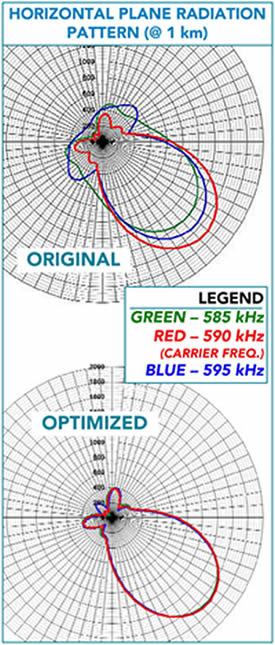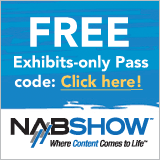
|
Methods for Improving AM Antenna Pattern Bandwidth 
AM radio stations employing directional antennas often cannot serve all of their coverage areas with acceptable quality because of pattern bandwidth distortion. A session at the upcoming NAB Broadcast Engineering Conference (BEC, April 9 - 14, 2011, Las Vegas, Nev.) titled "Radio Engineering Forum I" includes a paper, excerpted here, which presents methods for improving pattern bandwidth through modern design techniques, including a case study of a station with pattern bandwidth problems. This paper is entitled "AM Directional Antenna Pattern Performance Improvement Using Power Dissipation within the Phasing and Coupling System," and was written by Ron Rackley, Partner, du Treil, Lundin & Rackley, Inc. INTRODUCTION - AM antenna pattern bandwidth distortion results from the fact that the relationships between the carrier and sideband components required for linear transmission are not preserved as the signal passes through the antenna system. Since the tower electrical heights and spacings in an array differ between the carrier frequency and lower and upper sideband frequencies, differing directional antenna patterns are produced within the signal passband. Alteration of the sideband modulation components relative to the carrier by the differing pattern shapes is the underlying cause for pattern bandwidth distortion. A CASE STUDY - methods for improving pattern bandwidth through modern design are illustrated with a case study of an existing station that had well-known pattern bandwidth problems; there was an opportunity to resolve these problems when the transmitter site was rebuilt with new directional antenna equipment in 2009. The station, WDWD in Atlanta, Ga. employs a nighttime directional antenna that provides a classic example of dealing with pattern bandwidth issues, being a four-tower inline array on 590 kHz with suppressed null regions both on the back and sides of the pattern. For the design of the new WDWD phasing and coupling system, modern computer modeling techniques were used to evaluate alternate theoretical parameter sets for the required pattern shape as well as alternate phasing and coupling network designs for optimum bandwidth performance. PATTERN BANDWIDTH WITH CONVENTIONAL SYSTEM - to establish baseline performance for evaluating design options using broadbanding techniques, a generic phasing and coupling system was developed using a conventional power divider. It was modeled for pattern bandwidth at +/- 5, 10 and 15 kHz and the results were plotted, as shown here for the +/- 5 kHz case (upper plot in the figure at left). In the plot, the red line illustrates the antenna pattern at the carrier frequency of 590 kHz, while the green and blue lines illustrate the antenna pattern at 585 and 595 kHz, respectively. STUDY TO OPTIMIZE PHASING - in a somewhat analogous fashion to the techniques for sideband load rotation to improve the final amplifier bandwidth performance of AM transmitters, the effects of different overall phasing and coupling system phase shifts on how the tower feeds conform with each other at the power divider were studied to find the optimum situation for pattern bandwidth. The object was to find the phase shifts to build into the system between the power divider and the tower bases - including those associated with the power divider circuits, phase shifters, transmission lines and ATU matching networks - to give sideband pattern shapes that resemble the carrier pattern shape as closely as possible. The rotation corresponding to +165 degrees relative to the reference design, accomplished by shortening all of the initial assumed transmission lines by 165 electrical degrees, was chosen for the final system design (shown in the lower plot in the figure). RESULTS -WDWD has been operating with the new directional antenna phasing and coupling system since September of 2009. It has remained completely stable. The over-the-air results with negative power dissipation for the WDWD nighttime directional antenna pattern, by all accounts, have been astounding. Whereas it was impossible to listen on a standard car radio without hearing obvious distortion approximately half way around the transmitter site with the old system, it is now difficult to find the very small areas of distortion that are present on the back side of the pattern.
Mr. Rackley will
present this paper on Tuesday, April 12, 2011 starting at 9 a.m. in
room S228 of the Las Vegas Convention Center. It will also be included
in its entirety in the 2011 NAB Broadcast Engineering Conference
Proceedings, on sale at the 2011 NAB Show Store and available
on-line (after the Show) from the NAB Store (www.nabstore.com).
Other papers being presented during this session include the following: For additional conference information visit the NAB Show web page at www.nabshow.com. |
|
CEA's
Brian Markwalter to Keynote NAB Broadcast
Engineering Conference 
Come hear Brian Markwalter's keynote address at the Broadcast Engineering Conference on Sunday, April 10 at 9:00 a.m. titled, Change as Big as the Internet. In Brian's words, "In the beginning there was AM radio. Then came FM, doubling the number of channels on a radio receiver. Many years later came satellite radio, doubling the number of channels again. Now radio receivers are being connected to the Internet and the number of channels isn't just doubling, it's increasing exponentially. Television receivers have evolved similarly. They started with VHF, then expanded into UHF. Then cable and satellite TV spread across the land, dramatically increasing the number of channels on a typical receiver. But now, as TV receivers plug into the Internet, the amount of content available seems almost infinite. What does this mean for traditional AM, FM and TV receivers? That's what this talk will be about." Brian Markwalter
is Vice President of Research and Standards for the Consumer Electronics
Association (CEA) representing the $180 billion U.S. consumer
technology industry. Brian is responsible for overseeing CEA's
ANSI-accredited standards development operation, market research
capability and represents CEA's technical interests in industry
and international venues related to digital television, broadband
access, spectrum management, standards and intellectual property,
smart grid and energy efficiency. He holds BS and MS EE degrees
from the Georgia Institute of Technology. IEEE Broadcast Technology Society Issues Call for Papers 
A Call for Papers has been issued for the 2011 IEEE Broadcast Symposium, to be held October 19-21, 2011, in Alexandria, Va. The Symposium Committee seeks timely and relevant technical papers relating to all aspects of broadcast technology, in particular on the following topics:
The submission
deadline for abstracts is May 1, 2011. There is additional information
on the Symposium on the IEEE
Broadcast Technology Society website.
The March 21, 2011 Radio TechCheck is also available in an Adobe Acrobat file. Please click here to read the Adobe Acrobat version of Radio TechCheck. |


